Lead and Manage a Team within a Health and Social Care Setting Report
VerifiedAdded on 2019/12/03
|24
|7860
|698
Report
AI Summary
This report examines the features of effective team performance within a health and social care setting, specifically focusing on a care home for elderly residents with dementia. It explores the challenges faced by developing and established teams, including communication issues, lack of resources, and interpersonal differences, and proposes solutions such as improved communication, training, and the adoption of appropriate management styles. The report analyzes various management styles, including autocratic, democratic, and bureaucratic approaches, and their influence on team outcomes. It also covers how to support a positive team culture, develop a shared vision, create plans to meet objectives, support individual team members, and manage team performance. The report highlights the importance of leadership in fostering a supportive environment, setting clear objectives, and providing recognition for achievements to enhance the quality of care provided.

Lead and manage a team within a health and social care
Paraphrase This Document
Need a fresh take? Get an instant paraphrase of this document with our AI Paraphraser

Table of Contents
INTRODUCTION...........................................................................................................................5
TASK 1: THE FEATURES OF EFFECTIVE TEAM PERFORMANCE WITHIN A HEALTH
AND SOCIAL CARE OR CHILDREN AND YOUNG PEOPLE’S SETTING............................5
1.1 Explain the features of effective team performance..............................................................5
1.2 Identify the challenges experienced by developing teams.....................................................5
1.3 Identify the challenges experienced by established teams.....................................................5
1.4 Explain how challenges to effective team performance can be overcome............................6
1.5 Analyze how different management styles may influence outcomes of team performance.6
1.6 Analyse methods of developing and maintaining:.................................................................7
1.7 Compare methods of addressing conflict within a team........................................................7
TASK 2: SUPPORT A POSITIVE CULTURE WITHIN THE TEAM FOR A HEALTH AND
SOCIAL CARE OR CHILDREN AND YOUNG PEOPLE’S SETTING......................................8
2.1 Identify the components of a positive culture within own team............................................8
2.2 Demonstrate how own practice supports a positive culture in the team................................8
2.3 Use systems and processes to support a positive culture in the team....................................9
2.4 Encourage creative and innovative ways of working within the team..................................9
TASK 3: SUPPORT A SHARED VISION WITHIN THE TEAM FOR A HEALTH AND
SOCIAL CARE OR CHILDREN AND YOUNG PEOPLE’S SETTING......................................9
3.1 Identify the factors that influence the vision and strategic direction of the team..................9
3.2 Communicate the vision and strategic direction to team members.....................................10
3.3 Work with others to promote a shared vision within the team............................................10
3.4 Evaluate how the vision and strategic direction of the team influences team practice........10
INTRODUCTION...........................................................................................................................5
TASK 1: THE FEATURES OF EFFECTIVE TEAM PERFORMANCE WITHIN A HEALTH
AND SOCIAL CARE OR CHILDREN AND YOUNG PEOPLE’S SETTING............................5
1.1 Explain the features of effective team performance..............................................................5
1.2 Identify the challenges experienced by developing teams.....................................................5
1.3 Identify the challenges experienced by established teams.....................................................5
1.4 Explain how challenges to effective team performance can be overcome............................6
1.5 Analyze how different management styles may influence outcomes of team performance.6
1.6 Analyse methods of developing and maintaining:.................................................................7
1.7 Compare methods of addressing conflict within a team........................................................7
TASK 2: SUPPORT A POSITIVE CULTURE WITHIN THE TEAM FOR A HEALTH AND
SOCIAL CARE OR CHILDREN AND YOUNG PEOPLE’S SETTING......................................8
2.1 Identify the components of a positive culture within own team............................................8
2.2 Demonstrate how own practice supports a positive culture in the team................................8
2.3 Use systems and processes to support a positive culture in the team....................................9
2.4 Encourage creative and innovative ways of working within the team..................................9
TASK 3: SUPPORT A SHARED VISION WITHIN THE TEAM FOR A HEALTH AND
SOCIAL CARE OR CHILDREN AND YOUNG PEOPLE’S SETTING......................................9
3.1 Identify the factors that influence the vision and strategic direction of the team..................9
3.2 Communicate the vision and strategic direction to team members.....................................10
3.3 Work with others to promote a shared vision within the team............................................10
3.4 Evaluate how the vision and strategic direction of the team influences team practice........10

TASK 4: DEVELOP A PLAN WITH TEAM MEMBERS TO MEET AGREED OBJECTIVES
FOR A HEALTH AND SOCIAL CARE OR CHILDREN AND YOUNG PEOPLE’S SETTING
........................................................................................................................................................11
4.1 Identify team objectives.......................................................................................................11
4.2 Analyze how the skills, interests, knowledge and expertise within the team can meet
agreed objectives........................................................................................................................11
4.3 Facilitate team members to actively participate in the planning process.............................11
4.4 Encourage sharing of skills and knowledge between team members..................................12
4.5 Agree roles and responsibilities with team members..........................................................12
TASK 5: SUPPORT INDIVIDUAL TEAM MEMBERS TO WORK TOWARDS AGREED
OBJECTIVES IN A HEALTH AND SOCIAL CARE OR CHILDREN AND YOUNG
PEOPLE’S SETTING....................................................................................................................12
5.1 Set personal work objectives with team members based on agreed objectives...................12
5.2 Work with team members to identify opportunities for development and growth..............13
5.3Provide advice and support to team members to make the most of identified development
opportunities.............................................................................................................................. 13
5.4 Use a solution focused approach to support team members to address identified challenges
....................................................................................................................................................13
TASK 6: MANAGE TEAM PERFORMANCE IN A HEALTH AND SOCIAL CARE OR
CHILDREN AND YOUNG PEOPLE’S SETTING.....................................................................13
6.1 Monitor and evaluate progress towards agreed objectives..................................................13
6.2 Provide feedback on performance to:..................................................................................14
6.3 Provide recognition when individual and team objectives have been achieved..................14
6.4 Explain how team members are managed when performance does not meet requirements
....................................................................................................................................................14
CONCLUSION..............................................................................................................................15
REFERENCES.............................................................................................................................. 16
FOR A HEALTH AND SOCIAL CARE OR CHILDREN AND YOUNG PEOPLE’S SETTING
........................................................................................................................................................11
4.1 Identify team objectives.......................................................................................................11
4.2 Analyze how the skills, interests, knowledge and expertise within the team can meet
agreed objectives........................................................................................................................11
4.3 Facilitate team members to actively participate in the planning process.............................11
4.4 Encourage sharing of skills and knowledge between team members..................................12
4.5 Agree roles and responsibilities with team members..........................................................12
TASK 5: SUPPORT INDIVIDUAL TEAM MEMBERS TO WORK TOWARDS AGREED
OBJECTIVES IN A HEALTH AND SOCIAL CARE OR CHILDREN AND YOUNG
PEOPLE’S SETTING....................................................................................................................12
5.1 Set personal work objectives with team members based on agreed objectives...................12
5.2 Work with team members to identify opportunities for development and growth..............13
5.3Provide advice and support to team members to make the most of identified development
opportunities.............................................................................................................................. 13
5.4 Use a solution focused approach to support team members to address identified challenges
....................................................................................................................................................13
TASK 6: MANAGE TEAM PERFORMANCE IN A HEALTH AND SOCIAL CARE OR
CHILDREN AND YOUNG PEOPLE’S SETTING.....................................................................13
6.1 Monitor and evaluate progress towards agreed objectives..................................................13
6.2 Provide feedback on performance to:..................................................................................14
6.3 Provide recognition when individual and team objectives have been achieved..................14
6.4 Explain how team members are managed when performance does not meet requirements
....................................................................................................................................................14
CONCLUSION..............................................................................................................................15
REFERENCES.............................................................................................................................. 16
⊘ This is a preview!⊘
Do you want full access?
Subscribe today to unlock all pages.

Trusted by 1+ million students worldwide

Paraphrase This Document
Need a fresh take? Get an instant paraphrase of this document with our AI Paraphraser
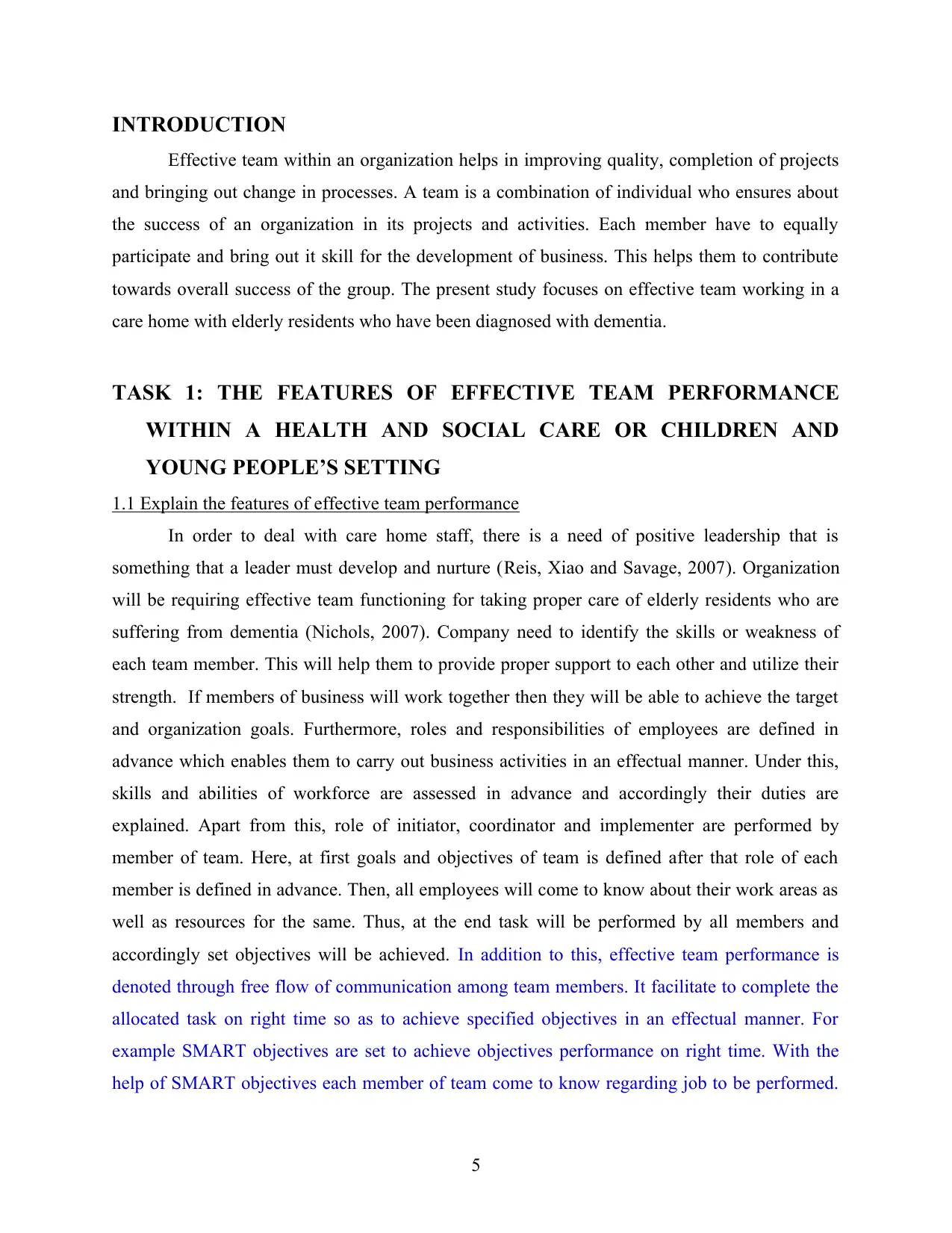
INTRODUCTION
Effective team within an organization helps in improving quality, completion of projects
and bringing out change in processes. A team is a combination of individual who ensures about
the success of an organization in its projects and activities. Each member have to equally
participate and bring out it skill for the development of business. This helps them to contribute
towards overall success of the group. The present study focuses on effective team working in a
care home with elderly residents who have been diagnosed with dementia.
TASK 1: THE FEATURES OF EFFECTIVE TEAM PERFORMANCE
WITHIN A HEALTH AND SOCIAL CARE OR CHILDREN AND
YOUNG PEOPLE’S SETTING
1.1 Explain the features of effective team performance
In order to deal with care home staff, there is a need of positive leadership that is
something that a leader must develop and nurture (Reis, Xiao and Savage, 2007). Organization
will be requiring effective team functioning for taking proper care of elderly residents who are
suffering from dementia (Nichols, 2007). Company need to identify the skills or weakness of
each team member. This will help them to provide proper support to each other and utilize their
strength. If members of business will work together then they will be able to achieve the target
and organization goals. Furthermore, roles and responsibilities of employees are defined in
advance which enables them to carry out business activities in an effectual manner. Under this,
skills and abilities of workforce are assessed in advance and accordingly their duties are
explained. Apart from this, role of initiator, coordinator and implementer are performed by
member of team. Here, at first goals and objectives of team is defined after that role of each
member is defined in advance. Then, all employees will come to know about their work areas as
well as resources for the same. Thus, at the end task will be performed by all members and
accordingly set objectives will be achieved. In addition to this, effective team performance is
denoted through free flow of communication among team members. It facilitate to complete the
allocated task on right time so as to achieve specified objectives in an effectual manner. For
example SMART objectives are set to achieve objectives performance on right time. With the
help of SMART objectives each member of team come to know regarding job to be performed.
5
Effective team within an organization helps in improving quality, completion of projects
and bringing out change in processes. A team is a combination of individual who ensures about
the success of an organization in its projects and activities. Each member have to equally
participate and bring out it skill for the development of business. This helps them to contribute
towards overall success of the group. The present study focuses on effective team working in a
care home with elderly residents who have been diagnosed with dementia.
TASK 1: THE FEATURES OF EFFECTIVE TEAM PERFORMANCE
WITHIN A HEALTH AND SOCIAL CARE OR CHILDREN AND
YOUNG PEOPLE’S SETTING
1.1 Explain the features of effective team performance
In order to deal with care home staff, there is a need of positive leadership that is
something that a leader must develop and nurture (Reis, Xiao and Savage, 2007). Organization
will be requiring effective team functioning for taking proper care of elderly residents who are
suffering from dementia (Nichols, 2007). Company need to identify the skills or weakness of
each team member. This will help them to provide proper support to each other and utilize their
strength. If members of business will work together then they will be able to achieve the target
and organization goals. Furthermore, roles and responsibilities of employees are defined in
advance which enables them to carry out business activities in an effectual manner. Under this,
skills and abilities of workforce are assessed in advance and accordingly their duties are
explained. Apart from this, role of initiator, coordinator and implementer are performed by
member of team. Here, at first goals and objectives of team is defined after that role of each
member is defined in advance. Then, all employees will come to know about their work areas as
well as resources for the same. Thus, at the end task will be performed by all members and
accordingly set objectives will be achieved. In addition to this, effective team performance is
denoted through free flow of communication among team members. It facilitate to complete the
allocated task on right time so as to achieve specified objectives in an effectual manner. For
example SMART objectives are set to achieve objectives performance on right time. With the
help of SMART objectives each member of team come to know regarding job to be performed.
5
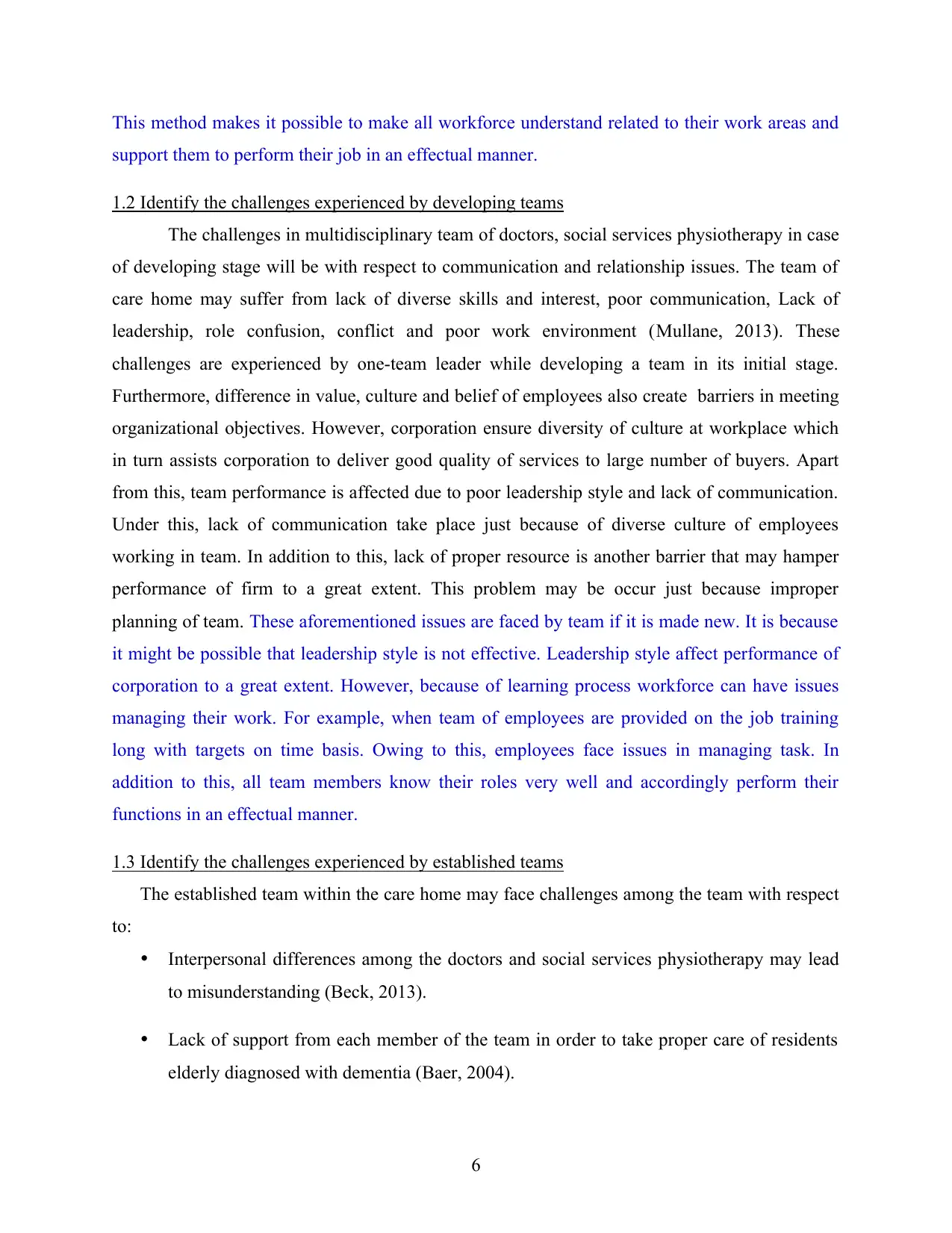
This method makes it possible to make all workforce understand related to their work areas and
support them to perform their job in an effectual manner.
1.2 Identify the challenges experienced by developing teams
The challenges in multidisciplinary team of doctors, social services physiotherapy in case
of developing stage will be with respect to communication and relationship issues. The team of
care home may suffer from lack of diverse skills and interest, poor communication, Lack of
leadership, role confusion, conflict and poor work environment (Mullane, 2013). These
challenges are experienced by one-team leader while developing a team in its initial stage.
Furthermore, difference in value, culture and belief of employees also create barriers in meeting
organizational objectives. However, corporation ensure diversity of culture at workplace which
in turn assists corporation to deliver good quality of services to large number of buyers. Apart
from this, team performance is affected due to poor leadership style and lack of communication.
Under this, lack of communication take place just because of diverse culture of employees
working in team. In addition to this, lack of proper resource is another barrier that may hamper
performance of firm to a great extent. This problem may be occur just because improper
planning of team. These aforementioned issues are faced by team if it is made new. It is because
it might be possible that leadership style is not effective. Leadership style affect performance of
corporation to a great extent. However, because of learning process workforce can have issues
managing their work. For example, when team of employees are provided on the job training
long with targets on time basis. Owing to this, employees face issues in managing task. In
addition to this, all team members know their roles very well and accordingly perform their
functions in an effectual manner.
1.3 Identify the challenges experienced by established teams
The established team within the care home may face challenges among the team with respect
to:
Interpersonal differences among the doctors and social services physiotherapy may lead
to misunderstanding (Beck, 2013).
Lack of support from each member of the team in order to take proper care of residents
elderly diagnosed with dementia (Baer, 2004).
6
support them to perform their job in an effectual manner.
1.2 Identify the challenges experienced by developing teams
The challenges in multidisciplinary team of doctors, social services physiotherapy in case
of developing stage will be with respect to communication and relationship issues. The team of
care home may suffer from lack of diverse skills and interest, poor communication, Lack of
leadership, role confusion, conflict and poor work environment (Mullane, 2013). These
challenges are experienced by one-team leader while developing a team in its initial stage.
Furthermore, difference in value, culture and belief of employees also create barriers in meeting
organizational objectives. However, corporation ensure diversity of culture at workplace which
in turn assists corporation to deliver good quality of services to large number of buyers. Apart
from this, team performance is affected due to poor leadership style and lack of communication.
Under this, lack of communication take place just because of diverse culture of employees
working in team. In addition to this, lack of proper resource is another barrier that may hamper
performance of firm to a great extent. This problem may be occur just because improper
planning of team. These aforementioned issues are faced by team if it is made new. It is because
it might be possible that leadership style is not effective. Leadership style affect performance of
corporation to a great extent. However, because of learning process workforce can have issues
managing their work. For example, when team of employees are provided on the job training
long with targets on time basis. Owing to this, employees face issues in managing task. In
addition to this, all team members know their roles very well and accordingly perform their
functions in an effectual manner.
1.3 Identify the challenges experienced by established teams
The established team within the care home may face challenges among the team with respect
to:
Interpersonal differences among the doctors and social services physiotherapy may lead
to misunderstanding (Beck, 2013).
Lack of support from each member of the team in order to take proper care of residents
elderly diagnosed with dementia (Baer, 2004).
6
⊘ This is a preview!⊘
Do you want full access?
Subscribe today to unlock all pages.

Trusted by 1+ million students worldwide
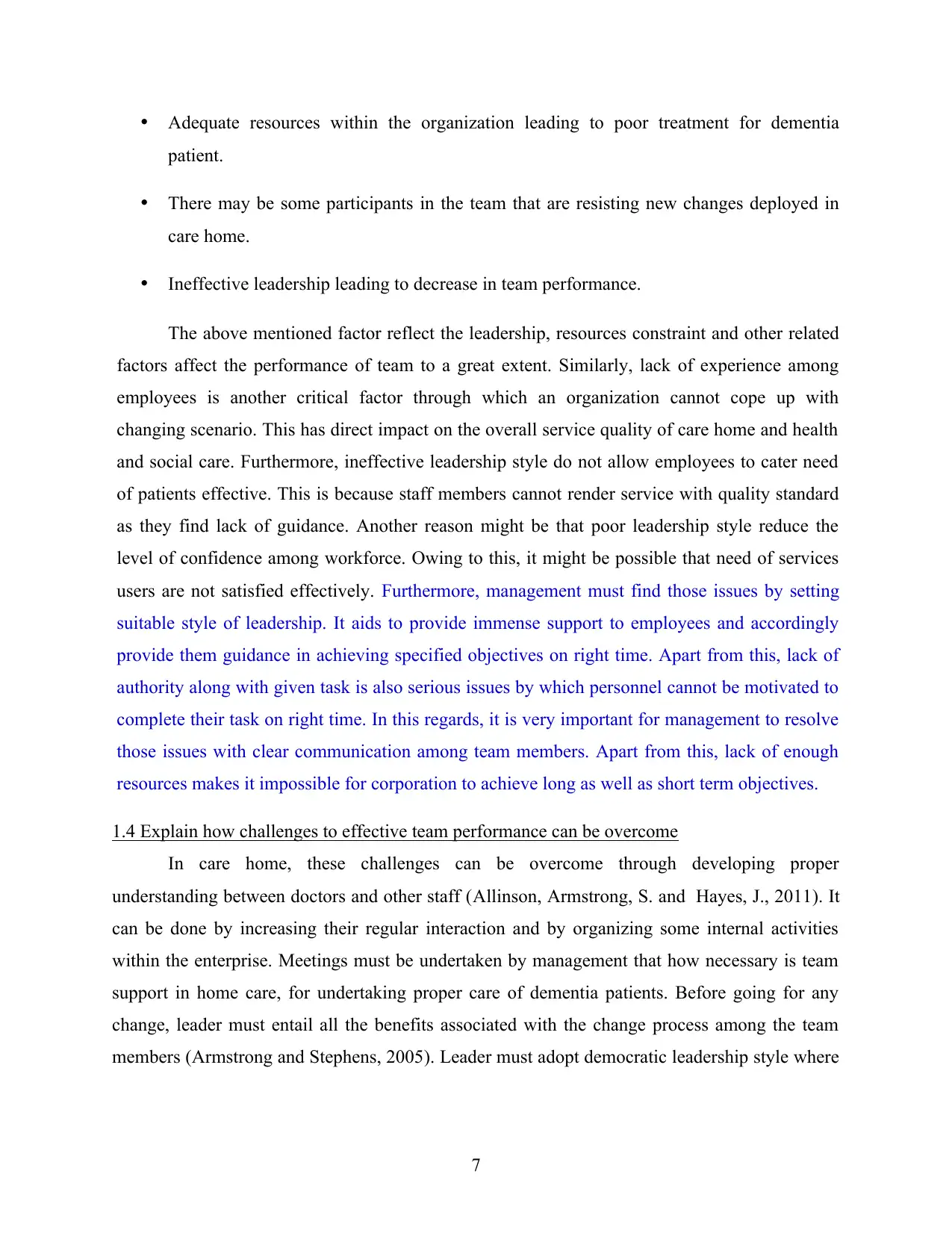
Adequate resources within the organization leading to poor treatment for dementia
patient.
There may be some participants in the team that are resisting new changes deployed in
care home.
Ineffective leadership leading to decrease in team performance.
The above mentioned factor reflect the leadership, resources constraint and other related
factors affect the performance of team to a great extent. Similarly, lack of experience among
employees is another critical factor through which an organization cannot cope up with
changing scenario. This has direct impact on the overall service quality of care home and health
and social care. Furthermore, ineffective leadership style do not allow employees to cater need
of patients effective. This is because staff members cannot render service with quality standard
as they find lack of guidance. Another reason might be that poor leadership style reduce the
level of confidence among workforce. Owing to this, it might be possible that need of services
users are not satisfied effectively. Furthermore, management must find those issues by setting
suitable style of leadership. It aids to provide immense support to employees and accordingly
provide them guidance in achieving specified objectives on right time. Apart from this, lack of
authority along with given task is also serious issues by which personnel cannot be motivated to
complete their task on right time. In this regards, it is very important for management to resolve
those issues with clear communication among team members. Apart from this, lack of enough
resources makes it impossible for corporation to achieve long as well as short term objectives.
1.4 Explain how challenges to effective team performance can be overcome
In care home, these challenges can be overcome through developing proper
understanding between doctors and other staff (Allinson, Armstrong, S. and Hayes, J., 2011). It
can be done by increasing their regular interaction and by organizing some internal activities
within the enterprise. Meetings must be undertaken by management that how necessary is team
support in home care, for undertaking proper care of dementia patients. Before going for any
change, leader must entail all the benefits associated with the change process among the team
members (Armstrong and Stephens, 2005). Leader must adopt democratic leadership style where
7
patient.
There may be some participants in the team that are resisting new changes deployed in
care home.
Ineffective leadership leading to decrease in team performance.
The above mentioned factor reflect the leadership, resources constraint and other related
factors affect the performance of team to a great extent. Similarly, lack of experience among
employees is another critical factor through which an organization cannot cope up with
changing scenario. This has direct impact on the overall service quality of care home and health
and social care. Furthermore, ineffective leadership style do not allow employees to cater need
of patients effective. This is because staff members cannot render service with quality standard
as they find lack of guidance. Another reason might be that poor leadership style reduce the
level of confidence among workforce. Owing to this, it might be possible that need of services
users are not satisfied effectively. Furthermore, management must find those issues by setting
suitable style of leadership. It aids to provide immense support to employees and accordingly
provide them guidance in achieving specified objectives on right time. Apart from this, lack of
authority along with given task is also serious issues by which personnel cannot be motivated to
complete their task on right time. In this regards, it is very important for management to resolve
those issues with clear communication among team members. Apart from this, lack of enough
resources makes it impossible for corporation to achieve long as well as short term objectives.
1.4 Explain how challenges to effective team performance can be overcome
In care home, these challenges can be overcome through developing proper
understanding between doctors and other staff (Allinson, Armstrong, S. and Hayes, J., 2011). It
can be done by increasing their regular interaction and by organizing some internal activities
within the enterprise. Meetings must be undertaken by management that how necessary is team
support in home care, for undertaking proper care of dementia patients. Before going for any
change, leader must entail all the benefits associated with the change process among the team
members (Armstrong and Stephens, 2005). Leader must adopt democratic leadership style where
7
Paraphrase This Document
Need a fresh take? Get an instant paraphrase of this document with our AI Paraphraser
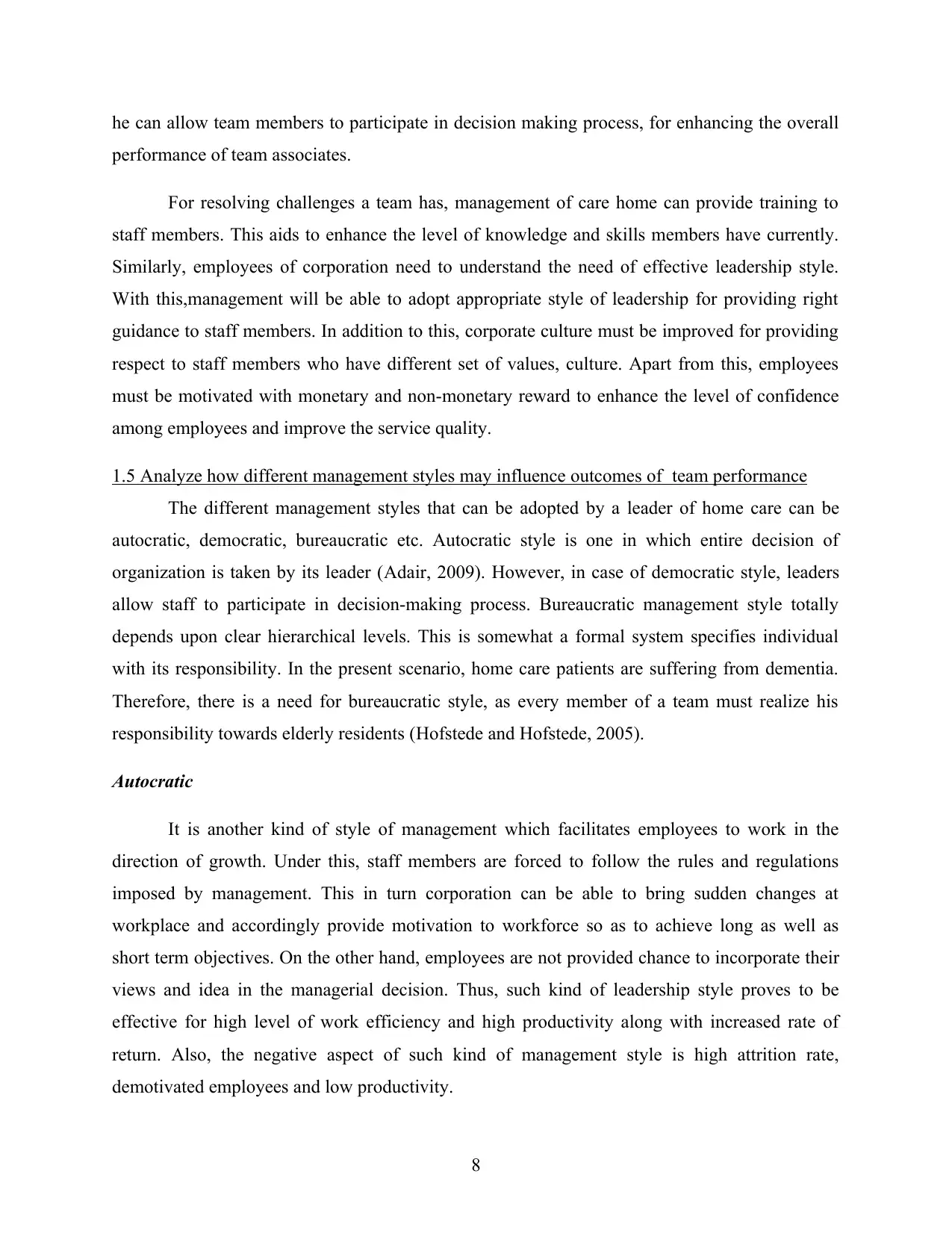
he can allow team members to participate in decision making process, for enhancing the overall
performance of team associates.
For resolving challenges a team has, management of care home can provide training to
staff members. This aids to enhance the level of knowledge and skills members have currently.
Similarly, employees of corporation need to understand the need of effective leadership style.
With this,management will be able to adopt appropriate style of leadership for providing right
guidance to staff members. In addition to this, corporate culture must be improved for providing
respect to staff members who have different set of values, culture. Apart from this, employees
must be motivated with monetary and non-monetary reward to enhance the level of confidence
among employees and improve the service quality.
1.5 Analyze how different management styles may influence outcomes of team performance
The different management styles that can be adopted by a leader of home care can be
autocratic, democratic, bureaucratic etc. Autocratic style is one in which entire decision of
organization is taken by its leader (Adair, 2009). However, in case of democratic style, leaders
allow staff to participate in decision-making process. Bureaucratic management style totally
depends upon clear hierarchical levels. This is somewhat a formal system specifies individual
with its responsibility. In the present scenario, home care patients are suffering from dementia.
Therefore, there is a need for bureaucratic style, as every member of a team must realize his
responsibility towards elderly residents (Hofstede and Hofstede, 2005).
Autocratic
It is another kind of style of management which facilitates employees to work in the
direction of growth. Under this, staff members are forced to follow the rules and regulations
imposed by management. This in turn corporation can be able to bring sudden changes at
workplace and accordingly provide motivation to workforce so as to achieve long as well as
short term objectives. On the other hand, employees are not provided chance to incorporate their
views and idea in the managerial decision. Thus, such kind of leadership style proves to be
effective for high level of work efficiency and high productivity along with increased rate of
return. Also, the negative aspect of such kind of management style is high attrition rate,
demotivated employees and low productivity.
8
performance of team associates.
For resolving challenges a team has, management of care home can provide training to
staff members. This aids to enhance the level of knowledge and skills members have currently.
Similarly, employees of corporation need to understand the need of effective leadership style.
With this,management will be able to adopt appropriate style of leadership for providing right
guidance to staff members. In addition to this, corporate culture must be improved for providing
respect to staff members who have different set of values, culture. Apart from this, employees
must be motivated with monetary and non-monetary reward to enhance the level of confidence
among employees and improve the service quality.
1.5 Analyze how different management styles may influence outcomes of team performance
The different management styles that can be adopted by a leader of home care can be
autocratic, democratic, bureaucratic etc. Autocratic style is one in which entire decision of
organization is taken by its leader (Adair, 2009). However, in case of democratic style, leaders
allow staff to participate in decision-making process. Bureaucratic management style totally
depends upon clear hierarchical levels. This is somewhat a formal system specifies individual
with its responsibility. In the present scenario, home care patients are suffering from dementia.
Therefore, there is a need for bureaucratic style, as every member of a team must realize his
responsibility towards elderly residents (Hofstede and Hofstede, 2005).
Autocratic
It is another kind of style of management which facilitates employees to work in the
direction of growth. Under this, staff members are forced to follow the rules and regulations
imposed by management. This in turn corporation can be able to bring sudden changes at
workplace and accordingly provide motivation to workforce so as to achieve long as well as
short term objectives. On the other hand, employees are not provided chance to incorporate their
views and idea in the managerial decision. Thus, such kind of leadership style proves to be
effective for high level of work efficiency and high productivity along with increased rate of
return. Also, the negative aspect of such kind of management style is high attrition rate,
demotivated employees and low productivity.
8
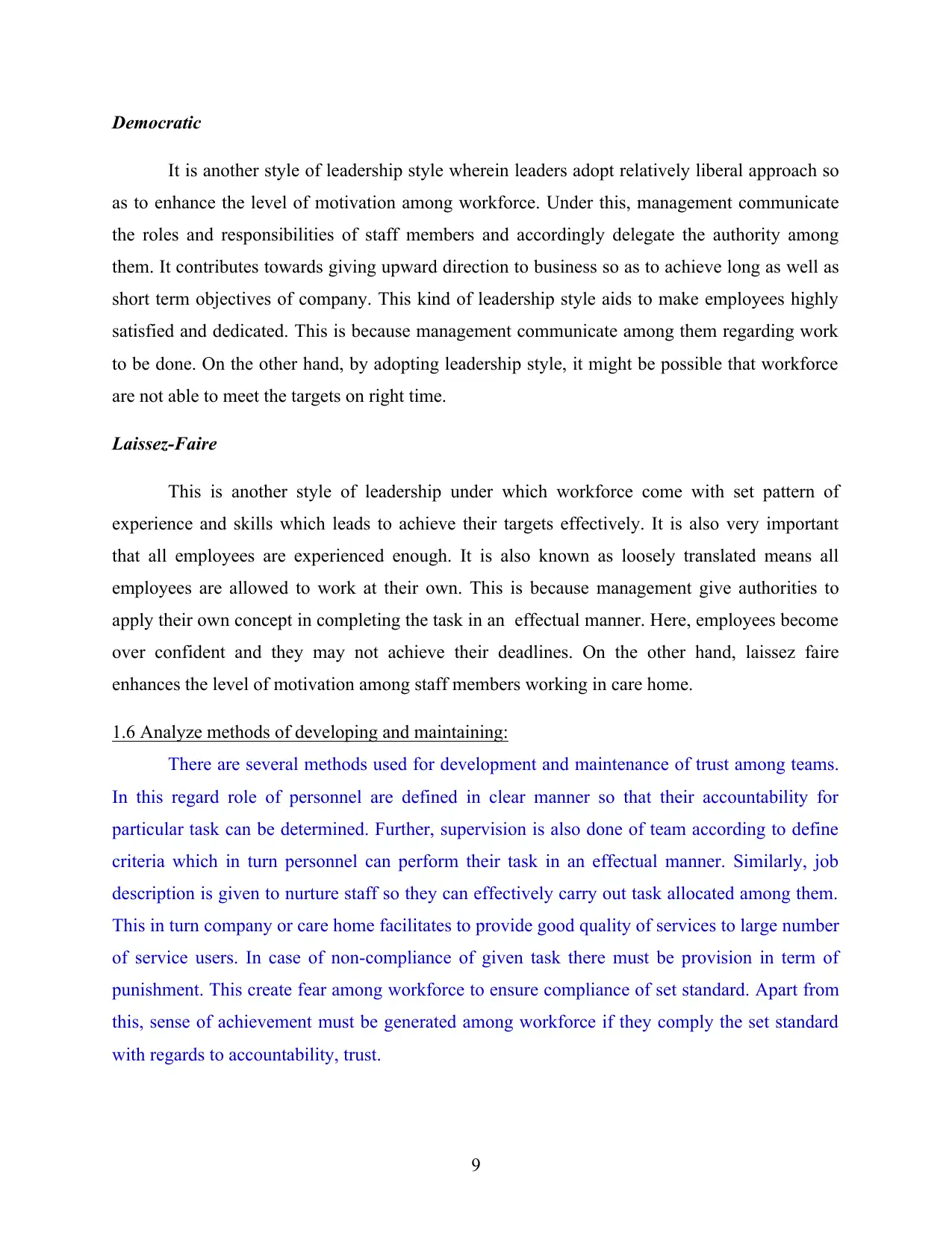
Democratic
It is another style of leadership style wherein leaders adopt relatively liberal approach so
as to enhance the level of motivation among workforce. Under this, management communicate
the roles and responsibilities of staff members and accordingly delegate the authority among
them. It contributes towards giving upward direction to business so as to achieve long as well as
short term objectives of company. This kind of leadership style aids to make employees highly
satisfied and dedicated. This is because management communicate among them regarding work
to be done. On the other hand, by adopting leadership style, it might be possible that workforce
are not able to meet the targets on right time.
Laissez-Faire
This is another style of leadership under which workforce come with set pattern of
experience and skills which leads to achieve their targets effectively. It is also very important
that all employees are experienced enough. It is also known as loosely translated means all
employees are allowed to work at their own. This is because management give authorities to
apply their own concept in completing the task in an effectual manner. Here, employees become
over confident and they may not achieve their deadlines. On the other hand, laissez faire
enhances the level of motivation among staff members working in care home.
1.6 Analyze methods of developing and maintaining:
There are several methods used for development and maintenance of trust among teams.
In this regard role of personnel are defined in clear manner so that their accountability for
particular task can be determined. Further, supervision is also done of team according to define
criteria which in turn personnel can perform their task in an effectual manner. Similarly, job
description is given to nurture staff so they can effectively carry out task allocated among them.
This in turn company or care home facilitates to provide good quality of services to large number
of service users. In case of non-compliance of given task there must be provision in term of
punishment. This create fear among workforce to ensure compliance of set standard. Apart from
this, sense of achievement must be generated among workforce if they comply the set standard
with regards to accountability, trust.
9
It is another style of leadership style wherein leaders adopt relatively liberal approach so
as to enhance the level of motivation among workforce. Under this, management communicate
the roles and responsibilities of staff members and accordingly delegate the authority among
them. It contributes towards giving upward direction to business so as to achieve long as well as
short term objectives of company. This kind of leadership style aids to make employees highly
satisfied and dedicated. This is because management communicate among them regarding work
to be done. On the other hand, by adopting leadership style, it might be possible that workforce
are not able to meet the targets on right time.
Laissez-Faire
This is another style of leadership under which workforce come with set pattern of
experience and skills which leads to achieve their targets effectively. It is also very important
that all employees are experienced enough. It is also known as loosely translated means all
employees are allowed to work at their own. This is because management give authorities to
apply their own concept in completing the task in an effectual manner. Here, employees become
over confident and they may not achieve their deadlines. On the other hand, laissez faire
enhances the level of motivation among staff members working in care home.
1.6 Analyze methods of developing and maintaining:
There are several methods used for development and maintenance of trust among teams.
In this regard role of personnel are defined in clear manner so that their accountability for
particular task can be determined. Further, supervision is also done of team according to define
criteria which in turn personnel can perform their task in an effectual manner. Similarly, job
description is given to nurture staff so they can effectively carry out task allocated among them.
This in turn company or care home facilitates to provide good quality of services to large number
of service users. In case of non-compliance of given task there must be provision in term of
punishment. This create fear among workforce to ensure compliance of set standard. Apart from
this, sense of achievement must be generated among workforce if they comply the set standard
with regards to accountability, trust.
9
⊘ This is a preview!⊘
Do you want full access?
Subscribe today to unlock all pages.

Trusted by 1+ million students worldwide
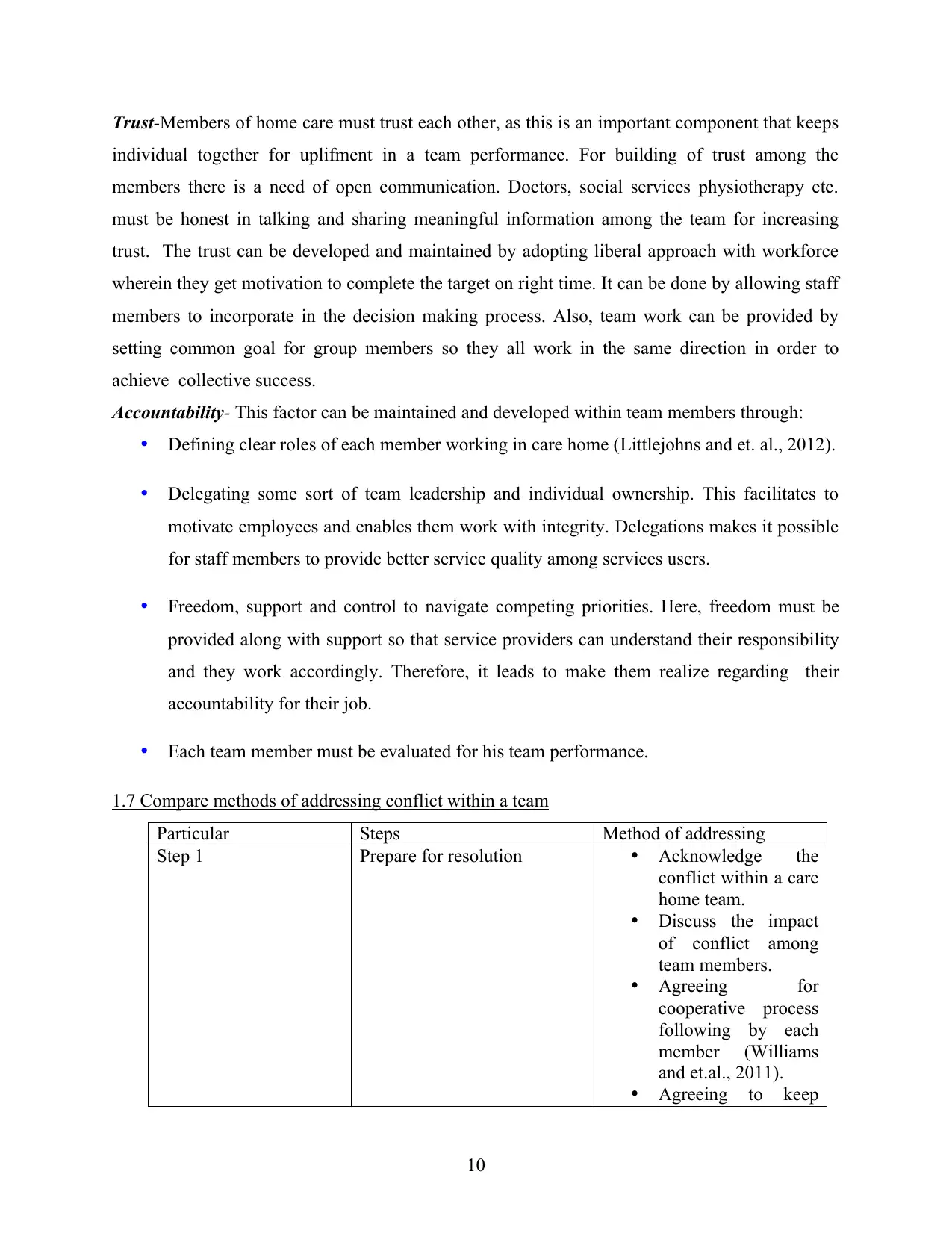
Trust-Members of home care must trust each other, as this is an important component that keeps
individual together for uplifment in a team performance. For building of trust among the
members there is a need of open communication. Doctors, social services physiotherapy etc.
must be honest in talking and sharing meaningful information among the team for increasing
trust. The trust can be developed and maintained by adopting liberal approach with workforce
wherein they get motivation to complete the target on right time. It can be done by allowing staff
members to incorporate in the decision making process. Also, team work can be provided by
setting common goal for group members so they all work in the same direction in order to
achieve collective success.
Accountability- This factor can be maintained and developed within team members through:
Defining clear roles of each member working in care home (Littlejohns and et. al., 2012).
Delegating some sort of team leadership and individual ownership. This facilitates to
motivate employees and enables them work with integrity. Delegations makes it possible
for staff members to provide better service quality among services users.
Freedom, support and control to navigate competing priorities. Here, freedom must be
provided along with support so that service providers can understand their responsibility
and they work accordingly. Therefore, it leads to make them realize regarding their
accountability for their job.
Each team member must be evaluated for his team performance.
1.7 Compare methods of addressing conflict within a team
Particular Steps Method of addressing
Step 1 Prepare for resolution Acknowledge the
conflict within a care
home team.
Discuss the impact
of conflict among
team members.
Agreeing for
cooperative process
following by each
member (Williams
and et.al., 2011).
Agreeing to keep
10
individual together for uplifment in a team performance. For building of trust among the
members there is a need of open communication. Doctors, social services physiotherapy etc.
must be honest in talking and sharing meaningful information among the team for increasing
trust. The trust can be developed and maintained by adopting liberal approach with workforce
wherein they get motivation to complete the target on right time. It can be done by allowing staff
members to incorporate in the decision making process. Also, team work can be provided by
setting common goal for group members so they all work in the same direction in order to
achieve collective success.
Accountability- This factor can be maintained and developed within team members through:
Defining clear roles of each member working in care home (Littlejohns and et. al., 2012).
Delegating some sort of team leadership and individual ownership. This facilitates to
motivate employees and enables them work with integrity. Delegations makes it possible
for staff members to provide better service quality among services users.
Freedom, support and control to navigate competing priorities. Here, freedom must be
provided along with support so that service providers can understand their responsibility
and they work accordingly. Therefore, it leads to make them realize regarding their
accountability for their job.
Each team member must be evaluated for his team performance.
1.7 Compare methods of addressing conflict within a team
Particular Steps Method of addressing
Step 1 Prepare for resolution Acknowledge the
conflict within a care
home team.
Discuss the impact
of conflict among
team members.
Agreeing for
cooperative process
following by each
member (Williams
and et.al., 2011).
Agreeing to keep
10
Paraphrase This Document
Need a fresh take? Get an instant paraphrase of this document with our AI Paraphraser
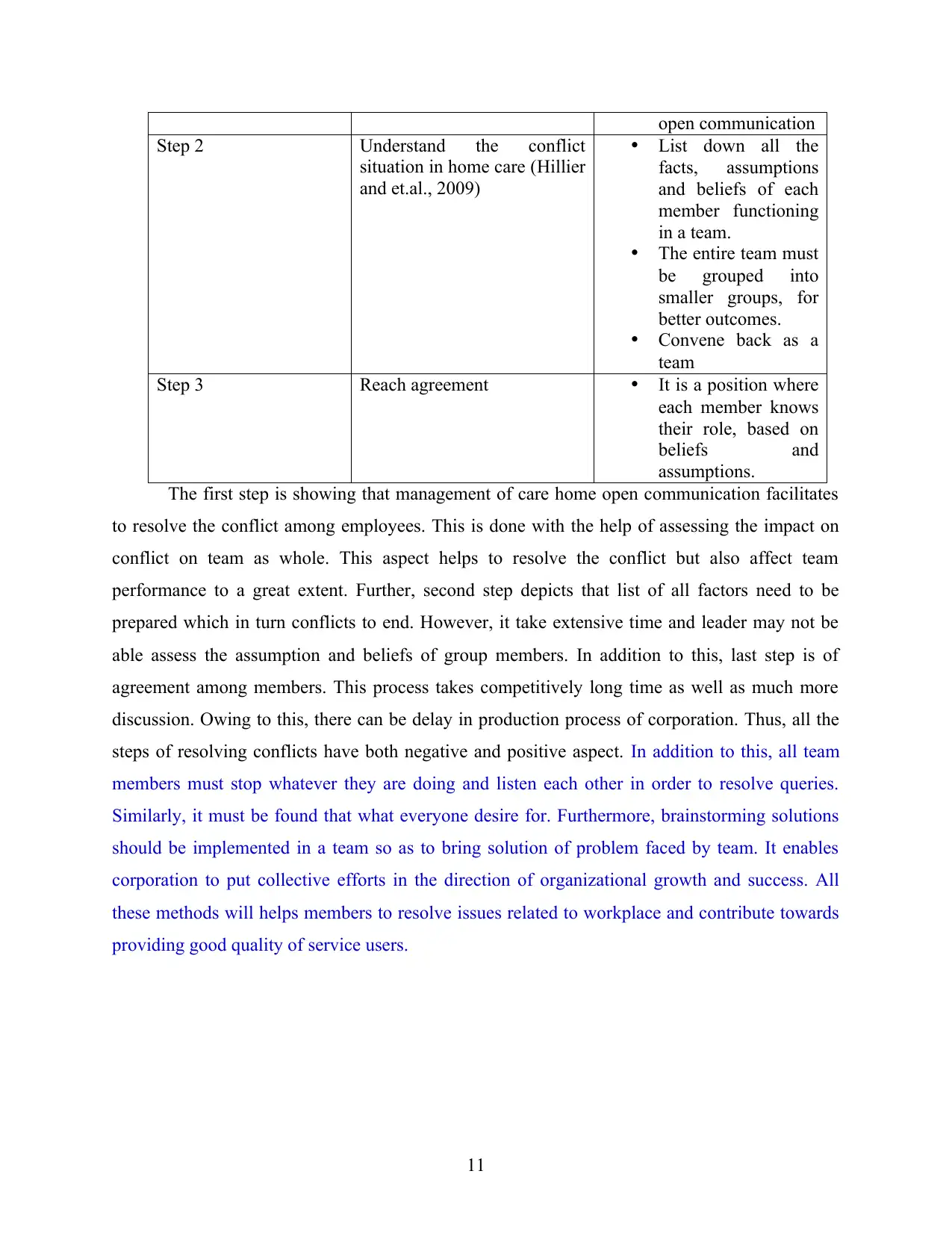
open communication
Step 2 Understand the conflict
situation in home care (Hillier
and et.al., 2009)
List down all the
facts, assumptions
and beliefs of each
member functioning
in a team.
The entire team must
be grouped into
smaller groups, for
better outcomes.
Convene back as a
team
Step 3 Reach agreement It is a position where
each member knows
their role, based on
beliefs and
assumptions.
The first step is showing that management of care home open communication facilitates
to resolve the conflict among employees. This is done with the help of assessing the impact on
conflict on team as whole. This aspect helps to resolve the conflict but also affect team
performance to a great extent. Further, second step depicts that list of all factors need to be
prepared which in turn conflicts to end. However, it take extensive time and leader may not be
able assess the assumption and beliefs of group members. In addition to this, last step is of
agreement among members. This process takes competitively long time as well as much more
discussion. Owing to this, there can be delay in production process of corporation. Thus, all the
steps of resolving conflicts have both negative and positive aspect. In addition to this, all team
members must stop whatever they are doing and listen each other in order to resolve queries.
Similarly, it must be found that what everyone desire for. Furthermore, brainstorming solutions
should be implemented in a team so as to bring solution of problem faced by team. It enables
corporation to put collective efforts in the direction of organizational growth and success. All
these methods will helps members to resolve issues related to workplace and contribute towards
providing good quality of service users.
11
Step 2 Understand the conflict
situation in home care (Hillier
and et.al., 2009)
List down all the
facts, assumptions
and beliefs of each
member functioning
in a team.
The entire team must
be grouped into
smaller groups, for
better outcomes.
Convene back as a
team
Step 3 Reach agreement It is a position where
each member knows
their role, based on
beliefs and
assumptions.
The first step is showing that management of care home open communication facilitates
to resolve the conflict among employees. This is done with the help of assessing the impact on
conflict on team as whole. This aspect helps to resolve the conflict but also affect team
performance to a great extent. Further, second step depicts that list of all factors need to be
prepared which in turn conflicts to end. However, it take extensive time and leader may not be
able assess the assumption and beliefs of group members. In addition to this, last step is of
agreement among members. This process takes competitively long time as well as much more
discussion. Owing to this, there can be delay in production process of corporation. Thus, all the
steps of resolving conflicts have both negative and positive aspect. In addition to this, all team
members must stop whatever they are doing and listen each other in order to resolve queries.
Similarly, it must be found that what everyone desire for. Furthermore, brainstorming solutions
should be implemented in a team so as to bring solution of problem faced by team. It enables
corporation to put collective efforts in the direction of organizational growth and success. All
these methods will helps members to resolve issues related to workplace and contribute towards
providing good quality of service users.
11
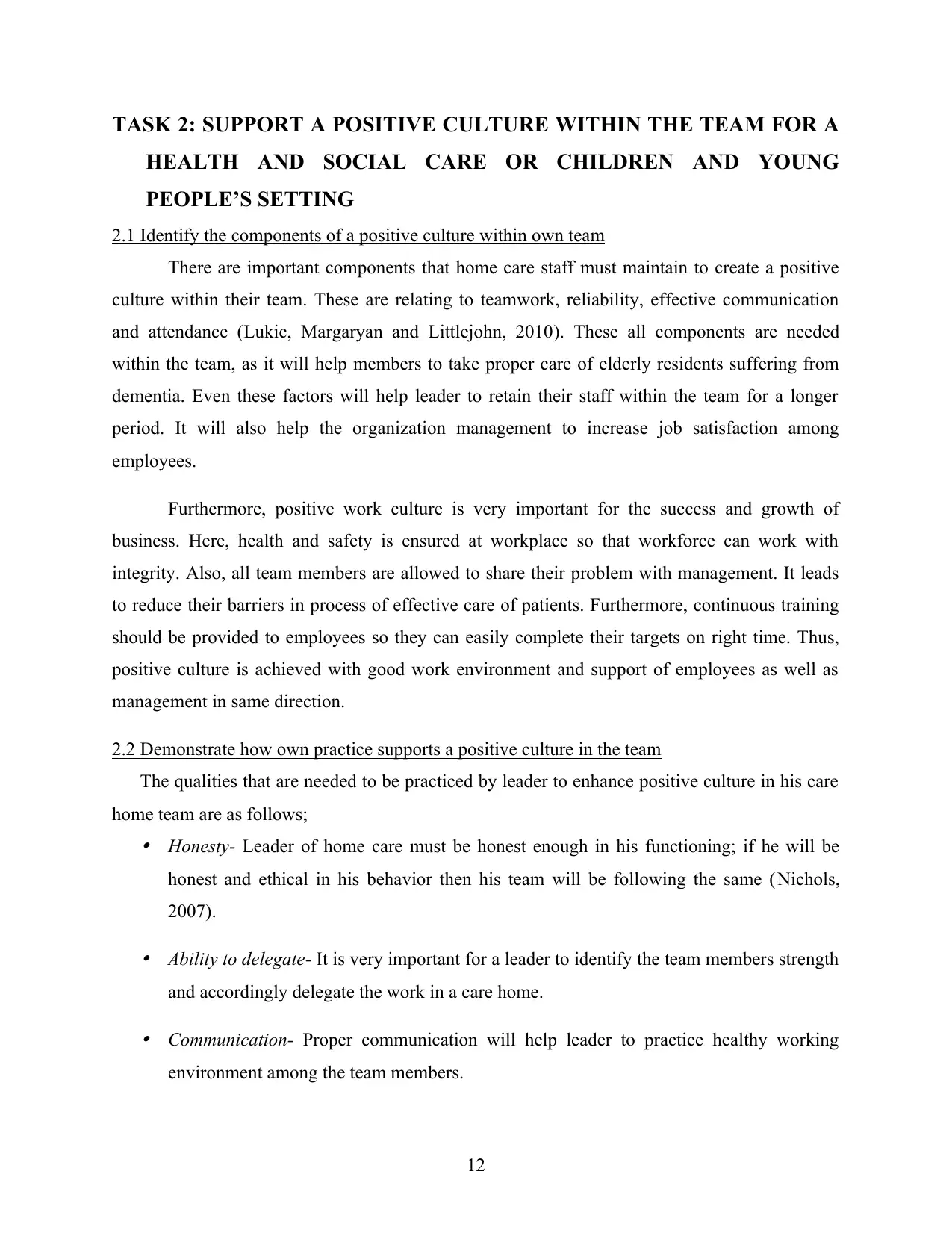
TASK 2: SUPPORT A POSITIVE CULTURE WITHIN THE TEAM FOR A
HEALTH AND SOCIAL CARE OR CHILDREN AND YOUNG
PEOPLE’S SETTING
2.1 Identify the components of a positive culture within own team
There are important components that home care staff must maintain to create a positive
culture within their team. These are relating to teamwork, reliability, effective communication
and attendance (Lukic, Margaryan and Littlejohn, 2010). These all components are needed
within the team, as it will help members to take proper care of elderly residents suffering from
dementia. Even these factors will help leader to retain their staff within the team for a longer
period. It will also help the organization management to increase job satisfaction among
employees.
Furthermore, positive work culture is very important for the success and growth of
business. Here, health and safety is ensured at workplace so that workforce can work with
integrity. Also, all team members are allowed to share their problem with management. It leads
to reduce their barriers in process of effective care of patients. Furthermore, continuous training
should be provided to employees so they can easily complete their targets on right time. Thus,
positive culture is achieved with good work environment and support of employees as well as
management in same direction.
2.2 Demonstrate how own practice supports a positive culture in the team
The qualities that are needed to be practiced by leader to enhance positive culture in his care
home team are as follows;
Honesty- Leader of home care must be honest enough in his functioning; if he will be
honest and ethical in his behavior then his team will be following the same (Nichols,
2007). Ability to delegate- It is very important for a leader to identify the team members strength
and accordingly delegate the work in a care home. Communication- Proper communication will help leader to practice healthy working
environment among the team members.
12
HEALTH AND SOCIAL CARE OR CHILDREN AND YOUNG
PEOPLE’S SETTING
2.1 Identify the components of a positive culture within own team
There are important components that home care staff must maintain to create a positive
culture within their team. These are relating to teamwork, reliability, effective communication
and attendance (Lukic, Margaryan and Littlejohn, 2010). These all components are needed
within the team, as it will help members to take proper care of elderly residents suffering from
dementia. Even these factors will help leader to retain their staff within the team for a longer
period. It will also help the organization management to increase job satisfaction among
employees.
Furthermore, positive work culture is very important for the success and growth of
business. Here, health and safety is ensured at workplace so that workforce can work with
integrity. Also, all team members are allowed to share their problem with management. It leads
to reduce their barriers in process of effective care of patients. Furthermore, continuous training
should be provided to employees so they can easily complete their targets on right time. Thus,
positive culture is achieved with good work environment and support of employees as well as
management in same direction.
2.2 Demonstrate how own practice supports a positive culture in the team
The qualities that are needed to be practiced by leader to enhance positive culture in his care
home team are as follows;
Honesty- Leader of home care must be honest enough in his functioning; if he will be
honest and ethical in his behavior then his team will be following the same (Nichols,
2007). Ability to delegate- It is very important for a leader to identify the team members strength
and accordingly delegate the work in a care home. Communication- Proper communication will help leader to practice healthy working
environment among the team members.
12
⊘ This is a preview!⊘
Do you want full access?
Subscribe today to unlock all pages.

Trusted by 1+ million students worldwide
1 out of 24
Related Documents
Your All-in-One AI-Powered Toolkit for Academic Success.
+13062052269
info@desklib.com
Available 24*7 on WhatsApp / Email
![[object Object]](/_next/static/media/star-bottom.7253800d.svg)
Unlock your academic potential
Copyright © 2020–2025 A2Z Services. All Rights Reserved. Developed and managed by ZUCOL.





